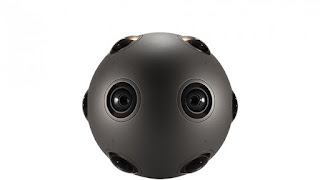It allows viewers to look behind them and see what’s going on. For once it’s not a line of dead-eyed kids shovelling popcorn into their popcorn holes, but more of the movie. It means you chose the camera angle and what you focus on. It make the whole thing very immersive when watched on 360 goggles.
 |
| 90% of pictures of people wearing these goggles are men with beards. |
What is interesting for the actor, is that the set is complete. You don’t have one or two walls missing filled with cameramen, sound operators, makeuppers, directors, runners, gaffers and dolly grips pushing it. It is quite immersive for the actor too. You are inside the set with just the other actors. Oh, and the camera.
 |
| Just what do you think you're doing, Dave? |
Because of the immersive nature of VR movies, the camera will nearly always be another character. The viewer feels like he or she is there, so they will so often be made a character in the film. Even if it’s just one that sits in the corner and looks around at the action taking place. Our movie very much involved the viewer and made them the focal point. It justified the fact that character can’t really have lines. And it made stuff happen all around them so that the viewer won’t get a stiff neck from staring in the same direction.
 |
| Virtual reality creepy guy on virtual reality hospital bed. |
But I like to characterise most film acting as walking from one point to another saying one line and then sitting out for two hours while they set up the next shot. It’s great. You only need to learn one or two lines at a time and you have so much time in between to read a book and lean the line for the next bit of the scene. Sometimes you have to just stand there and deliver the line, which is even easier. Or you have to deliver a line whist pretending to hit someone in the face or shoot a gun, but it’ll always take 3 days to shoot this, and most of the time there will be someone who knows how to hit someone in the face does it for you with a wig just like your hair so they can film it from behind and it makes it look like you have a clue what you were doing.
Anyway, this is a huge step into the future of film, but there are currently limitations in terms of integrating it with moving, and the possibility of all the sort of edits that allow time jumps and emphasis in stories. There will be a few very interesting films (and games) made using this, and lots and lots of point-of-view porn, but I am not sure it will take over current movie production techniques, where the story is often told through the cuts, focus and angles, for a while. But I do feel it will fuel a new branch of filmmaking. I’m very proud to be at the forefront of that.